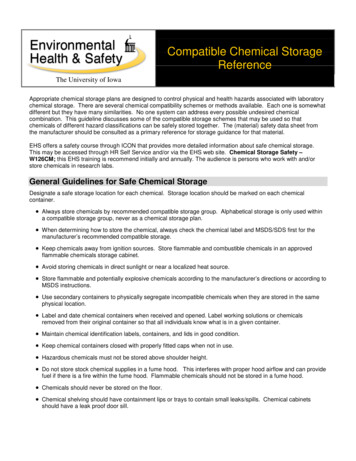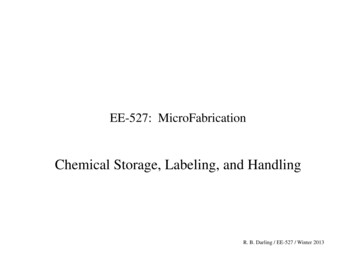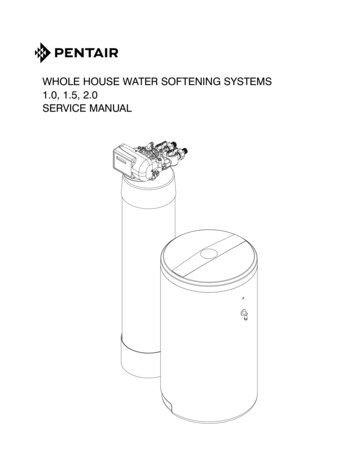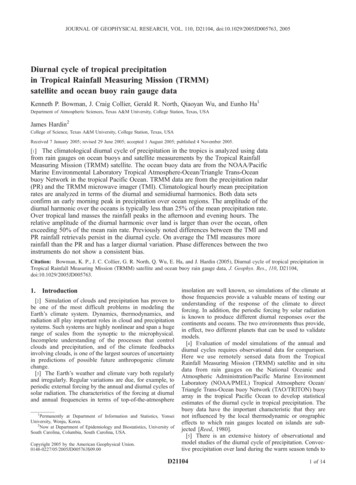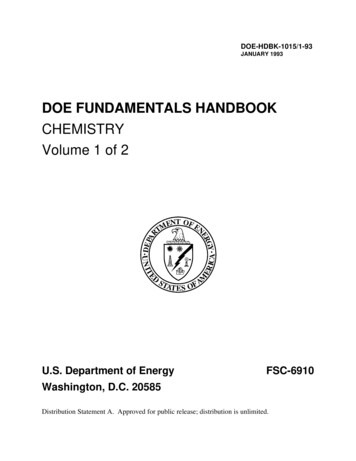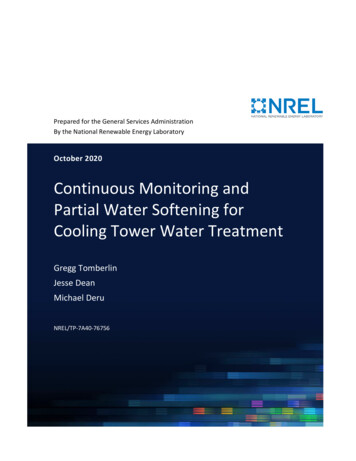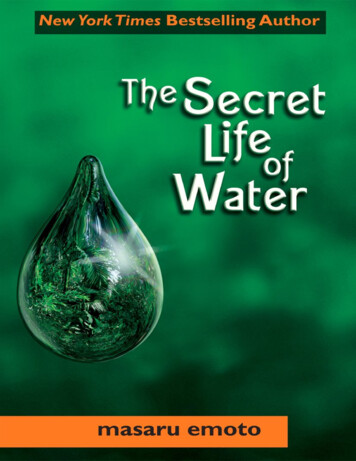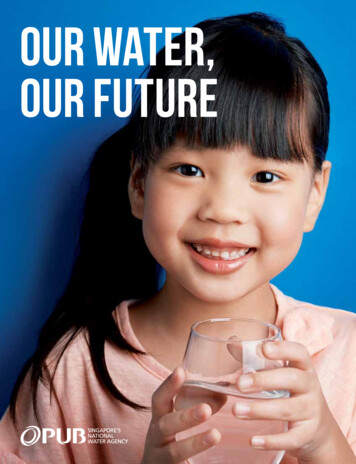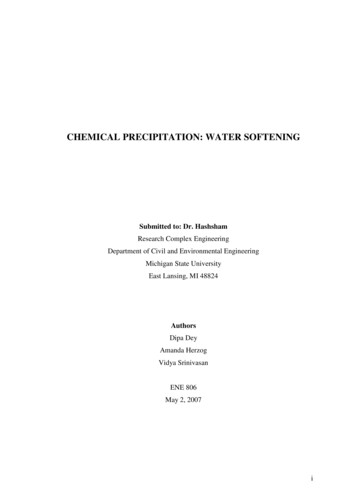
Transcription
CHEMICAL PRECIPITATION: WATER SOFTENINGSubmitted to: Dr. HashshamResearch Complex EngineeringDepartment of Civil and Environmental EngineeringMichigan State UniversityEast Lansing, MI 48824AuthorsDipa DeyAmanda HerzogVidya SrinivasanENE 806May 2, 2007i
AcknowledgementWe are grateful to Dr. Syed A. Hashsham for his invaluable guidance andsupport during the course of this project. We would also like to thank Mr.Joseph Nguyen for his assistance and cooperation.May 2, 2007Dipa DeyAmanda HerzogVidya Srinivasanii
CONTENTSCaptionPage No.Title pageiAcknowledgementiiContentsiiiList of Figures and TablesivAbstract1Introduction2Chemistry of Hardness Removal Process3Objective5Methods and Materials5Results and discussion6Conclusions8References9Appendix -110RAW DATA10Appendix-211Sample Calculation to Determine the Lime Dosage11Appendix-313Water Softening and alkalinity Protocol13Appendix-416Pictures16iii
LIST OF FIGURES AND TABLESCaptionPage No.Figure 1: Variation of hardness, alkalinity and pH for varying lime6dosages (run1)Figure 2: Variation of hardness, alkalinity and pH for varying lime7dosages (run2)Figure3: Comparison of replicate runs8Setup and Samples with lime dosages16Floc. Formation16Filtration Setup16Samples After Filtration16Before Titration16Mid-Titration16End of Titration16Table 1: : Run1 for varying lime dosages10Table2: Run2 for varying lime dosages10iv
ABSTRACTHard water can cause many problems including scaling and excessive soap consumption.In the United States, hard water is mostly found in the mid western and western states. Itranges between 120-250 mg/L as CaCO3 or beyond 250 mg/L as CaCO3 for very hardwaters. The acceptable water hardness range is between 60-120 mg/L as CaCO3. A watersoftening experiment was conducted in replicate to observe the changes in parameterssuch as total hardness, calcium hardness, magnesium hardness, alkalinity and pH withvarying dosages of lime. A lime dosage range of 30-180% of the stoichiometric amountwas chosen for the experiments. The sample used was groundwater from an East Lansingwell which had a total hardness of 332 mg/L as CaCO3. Results indicated that an increasein lime dosage upto 90% caused a decrease in total hardness, alkalinity, magnesiumhardness and calcium hardness concentrations. However, for a lime dosage beyond120%, the total hardness, alkalinity, and calcium hardness concentrations increased whilemagnesium hardness concentration decreased to lower values.The pH continuallyincreased for a lime dosage between 30% and 180%.1
INTRODUCTIONHard water is the most common water quality problem reported by consumers throughoutthe United States. More than 60 percent of the Earth’s water is ground water and hardwater is found in more than 85% of the country. The water travels through rocks and soilpicking up minerals including calcium and magnesium, ions which produce hard water.(Water Review, Consumer report, 1990).Hard water interferes with almost every cleaning task from laundering and dishwashing tobathing and personal grooming (IANR, Water Quality 1996). Clothes laundered in hardwater may look dingy and feel harsh and scratchy. Dealing with hard water problems inthe home can be a nuisance. In addition, hard water affects the amount of soap anddetergent necessary for cleaning. Soap used in hard water combines with the minerals toform a sticky soap curd. Some synthetic detergents are less effective in hard waterbecause the active ingredient is partially inactivated by hardness, even though it staysdissolved.Bathing with soap in hard water leaves a film of sticky soap curd on theskin. The film may prevent removal of dirt and bacteria. Soap curd interferes with thereturn of skin to its normal, slightly acid condition, and may lead to irritation. Soap curdon hair may make it dull, lifeless and difficult to manage.Hard water also contributes to inefficient and costly operation of water treatmentequipment. Heated hard water forms a scale of calcium and magnesium minerals that cancontribute to the inefficient operation or failure of water treatment equipment . Pipes canbecome clogged with scale which reduces water flow and ultimately results in pipereplacement.Hard water is not a health hazard. In fact, the National Research Council (NationalAcademy of Sciences) states that drinking hard water generally contributes to the totalcalcium and magnesium needs in humans.Water utilities struggling with source water that contains high amounts of calcium and/ormagnesium often turn to lime softening to remove hardness. Raising treatment pH above9.6 converts soluble calcium bicarbonate hardness to insoluble calcium carbonate. Anincrease in pH beyond 10.6 converts soluble magnesium bicarbonate to insolublemagnesium hydroxide. Aggressive magnesium removal often requires a treatment pH of11 or higher, a process known as excess lime softening (Jones, C; et.al. 2005).2
Chemistry of Hardness Removal ProcessDuring precipitation softening, calcium is removed form water in the form of CaCO3precipitate and magnesium is removed as Mg(OH)2 precipitate (Frederick W. Pontius).The carbonic acid concentration present and the pH play an important role in theprecipitation of these two solids. Carbonate hardness can be removed by the addition ofhydroxide ions and raising the pH by which the bicarbonate ions are converted tocarbonate form having a pH above 10. Due to the increase in carbonate concentration,precipitates of calcium carbonate is formed. The remaining calcium, i.e. non carbonatehardness, cannot be removed by simple adjustment of pH. Therefore, soda ash (sodiumcarbonate) must be externally added to precipitate this remaining calcium. Magnesium isremoved due to the precipitation of magnesium hydroxide. In the lime soda ash process,lime is added to raise the pH while sodium carbonate is added to provide a source ofcarbonate ion.H 2 CO3 Ca (OH ) 2 CaCO3 2 H 2 O(1)Eq.(1) is the neutralization reaction between CO2 carbonic acid and lime. This equationdoes not result any net change in water hardness. This also suggest that for each mg/L ofcarbonic acid expressed as CaCO3 present, 1mg/L of lime expressed as CaCO3 will berequired for neutralization by knowing the stoichiometric ratios.Ca 2 2 HCO3 Ca (OH ) 2 2CaCO3 ( s ) 2 H 2 O(2)Eq.(2) presents the removal of calcium carbonate hardness. It also shows that for eachmolecule of calcium bicarbonate present, two carbonate ions can be formed by increasingthe pH. This also suggest that for each mg/L of calcium bicarbonate present, 1mg/L oflime expressed as CaCO3 will be required for its removal by knowing the stoichiometricratios between them. SO42 SO42 Ca 2 NaCO CaCO 2Na 233 2Cl 2Cl (3)Eq.(3) reflects the removal of calcium noncarbonated hardness. The stoichiometriccoefficient suggest that for each mg/L of calcium noncarbonate hardness present, 1mg/Lof sodium carbonate expressed as CaCO3 will be required for its removal.3
Mg 2 2 HCO3 2Ca (OH ) 2 2CaCO3 Mg (OH ) 2 ( s ) 2 H 2 O(4)Eq. (4) is similar to eq.(2). If the magnesium bicarbonate and lime are expressed asCaCO3 , then the stoichiometric ratios suggest that for each mg/L of magnesiumbicarbonate hardness present, 2 mg/L of lime expressed as CaCO3 will be needed for itsremoval. SO42 SO42 Mg 2 Ca(OH) Mg(OH)(s) Ca 32 2Cl 2Cl (5)Eq. (5) represents the removal of magnesium noncarbonate hardness. If the magnesiumnoncarbonate hardness and lime are expressed as CaCO3 , stoichiometric ratios suggestthat for each mg/L of magnesium noncarbonate hardness present, 1 mg/L of limeexpressed as CaCO3 will be needed for its removal. Here no net change in the hardnesslevel resulted as for each magnesium ion removed calcium ion is added.Thus to complete the hardness removal process, sodium carbonate required to be added toprecipitate the calcium as presented in the equation below.Ca2 SO42 SO42 Na 2 CO3 CaCO3 ( s ) 2 Na 2Cl 2Cl (6)4
OBJECTIVEThe objective of the water softening experiment was to determine the effects of varyinglime dosages on parameters such as total hardness, calcium hardness, magnesiumhardness, alkalinity and pH.METHODS and MATERIALSVery hard ground water was obtained from a well located in East Lansing provided byJoseph Nguyen. Initial sample characteristics such as pH, alkalinity, and total hardnessare provided in Appendix 2. A lime, Ca(OH)2, stock solution of 10mg/mL was preparedfor dosing the sample with 30, 60, 90, 120, 150 and 180 percent of the stoichiometricamount of lime. The jar test was executed with the conventional apparatus with six 2-literbeakers (Appendix-2) mixing the groundwater with the various amounts of lime for 20min at 30 rpm. The samples were then filtered through 0.45µm filter and then titrated fortotal hardness, calcium hardness, and alkalinity. In addition pH and magnesium hardnesswere noted down.This experiment was done in replicate to compare results anddetermine the degree of experimental error.Detailed protocols for this experiment,including titrations and calculations, are available in the appendix.5
RESULTS and DISSCUSSIONRun 1: Water SofteningReplicate 1: Variation of Hardness, Alkalinity and pH for varying Lime dosages1330012250pH11200Total Hardness15010pHConcentartion, mg/L as CaCO3350Alkalinity9100Magnesium HardnessCalcium Hardness50807020406080100120140160180Lime dose, % Stoichiometric AmountFigure 1: Variation of Hardness, Alkalinity and pH for varying Lime dosages (Run1)Replicate runs for the water softening experiment evaluated parameters such as alkalinity,hardness and pH in response to varying lime dosages from 30% to 180% of thestoichiometric amount. In Run 1, the total hardness reached a minimum value ofapproximately 160 mg/L as CaCO3 for a lime dosage of 90% (fig.1). The calciumhardness first decreased in concentration to a minimum of 35mg/L as CaCO3 for a limedosage of 90% and then after that continued to increase in concentration with an increaseof lime dosage. This increase in calcium hardness was observed due to the addition ofexcess lime and the absence of alkalinity caused by carbonates. The plateau between 60%and 90% of lime is due to the presence of extra alkalinity. Any excess lime added in thisregion converts bicarbonates to carbonates and those carbonates combine with the freecalcium ions to form precipitates.Magnesium hardness concentration decreased with the increasing dosage of lime.Alkalinity decreased to a minimum at approximately 90% of lime and increasedthereafter.This is due to the addition of lime and the precipitation of species, whichconsumes alkalinity that causes the initial decrease. At lime dosages higher than 120%,alkalinity increases due to an addition of excess lime. For every addition of lime, free6
OH- ions are released, therefore an increase in OH- ions is responsible for an increase inpH.Run 2: Water SofteningReplicate 2: Variation of Hardness, Alkalinity and pH for various Lime dosages131230011pH20010Total HardnesspHConcentration, mg/L as CaCO3400Alkalinity9100Magnesium Hardness8Calcium Hardness07020406080100120140160180Lime dose, % Stoichiometric AmountFigure 2: Variation of Hardness, Alkalinity and pH for varying Lime dosages (Run2)In Run 2, the total hardness reaches a minimum value of approximately 160 mg/L asCaCO3 for a lime dosage of 120% (fig.2). The calcium hardness concentration firstdecreases to a minimum of 35 mg/L as CaCO3 for a lime dosage of 60% and then starts toincrease above a lime dosage of 90%. This result was due to the addition of excess limeand the absence of alkalinity caused by carbonates. The plateau between 60% and 90%of lime was because of the presence of extra alkalinity. Any excess lime added in thisregion converts bicarbonates to carbonates and combine with the free calcium ions toform precipitates.Magnesium hardness decreases with an increase in lime dosage and reaches aconcentration of 30mg/L as CaCO3, for a lime dosage of 180%. This concentrationindicates an approximate solubility limit of magnesium ions. In addition alkalinitydecreased to a minimum around 90% of lime but increases thereafter.The trendsobserved in Run1 and Run2 were in good correlation with each other.7
Comparative Study of Replicate Runs : Water Softening400y 1.0797x2R 0.8977350300Run 2250200150Magnesium Hardness, mg/L as CaCO3100Alkalinity, mg/L as CaCO3Total Hardness, mg/L as CaCO350Calcium Hardness, mg/L as CaCO3Linear Trendline00100200300400Run 1Figure 3: Comparison of Replicate RunsThis plot is a comparative study of the data obtained from run 1 and run2. The data fromeach run have an R2 correlation of 0.90 for the parameters of this study.Hence, theexperiment is reproducible and the trends observed for each parameter in response tovarying lime dosages are in agreement with the expected trends.CONCLUSIONSThis experiment yielded the following conclusions: Calcium hardness concentrations decreased with an increase in lime dosage butconcentrations increased at dosages higher than 90%. Magnesium hardness decrease with an increase in lime dosage, especially whencalcium hardness was increased (dosage higher than 90%) Alkalinity decreased to a minimum value of approximately 135 mg/L as CaCO3 ata lime dosage of 90% and increased thereafter due to the addition of excess lime. pH increased with an increase in lime dosage due to the generation of free OHions. The replicate runs conducted were in correlation with each other, therebydemonstrating reproducibility.8
REFERENCES1. IANR, Water Resources management, Water Quality, 1996.2. Jones, C; Corriagn,T; Graham, D.B; McMullen, L.D, 2005. “Reduced Lime Feed:Effects on Operational Costs and water Quality”.3. Syed Hashsham. Chemical Precipitation: Water Softening. Lab Report, 19934. Water Quality and Treatment: A Handbook of Community Water Supplies.American Water Works Association. Fourth edition, 19905. Water Review, Consumer Report, Vol.5,No.1. 1990. A publication of the waterquality research council6. Water Treatment Principles and Design. MWH. Second edition, 20059
APPENDIX 1 – RAW DATATable1: Run 111212Table2: Run 78.4101011121210
APPENDIX 2 – Sample Calculation to Determine the Lime DosageSample: Ground waterpH 7.72Ca2 200 mg/LMg2 132 mg/LTemperature 20 0CAlkalinity 311 mg/LTotal Hardness 332 mg/LCarbonate Hardness Alkalinity 311 mg/L CaCO3Non Carbonate hardness Total hardness- Alkalinity 21 mg/L CaCO3From the above values we know that it is an excess lime soda –ash process0332200Ca2 Mg2 Other CationsOther AnionsHCO33110Step1: Assume pH 7, so all alkalinity is in the bicarbonate forma) [HCO3] 311 (6111) () ( ) 6.22 x 10-3 mol/L50100061b) K1 1014.8435- 3404.71 /293 – 0.032786 (293)K1 4.26 x 10-7K2 106.498- 2909.39/293-0.02379(293)K2 3.97 x 10-11c) α 1 1 10 7 1 10 71/ K 1 1 K 2 / 1 10 7/ 4.26 10 71 1 3.97 10 11 / 1 10 7 0.8111
d) CT 6.22 10 3 7.679 10 3 mol/L0.81e) [HCO3*] 7.679 x 10-3-6.22 x 10 -3 1.477 x 10 -3 mol/L[HCO3*] 1.477 x 10 -3 mol/L x 62 g/mol 0.0915 g/L 91.5 mg/L[HCO3*] 147.7 mg/L CaCO3147.70332200Ca2 Mg2 Other CationsH2CO3 147.7Other AnionsHCO3-147.70311Step2:Total Hardness 332 mg/LCa2 Carbonate Hardness 200 mg/LCa2 Non Carbonate Hardness 0 mg/LMg2 Carbonate Hardness 311-200 111 mg/LMg2 Non Carbonate Hardness 332-311 21 mg/LStep3:Lime Dosage:147.7 200 2(111) 21 590.7 mg/L as CaCO3590.7 X (37/50) 437.118 mg/L as Ca(OH)2Soda Ash dose: 0 21 21 mg/L as CaCO3Soda ash dose 21 53 22.26 mg/L as Na2CO35012
APPENDIX 3 - Water Softening and alkalinity ProtocolWater Softening ProtocolTRIAL RUN:1. Prepare a Lime stock of 10 mg/mL2. Prepare 0.1 M EDTA stock3. Using ground water samples measure Total hardness, Calcium hardness,Magnesium hardness, Alkalinity, pH and Temperaturea. Total hardness, Calcium hardness and Alkalinity protocols attached at theend of this document.4. Determine the appropriate water softening process:a. i.e. East Lansing well water excess lime soda-ash5. Calculate and add lime dosage for 100% stoichiometric amount to a liter ofground watera. Use AWWA equations for dosage calculation2. Conduct flocculation for 20 min at 30 RPM3. Filter the entire sample through 0.45 uL filter (smooth side of filter facing down inthe funnel)4. Collect supernatant and measure Alkalinity, Calcium and Total hardness and pH5. Calculate Magnesium hardnessRUN 1 & 2:1. Calculate and add lime dosage for 30, 60, 90, 120, 150, and 180% of thestoichiometric amount to a liter of ground water.a. Use AWWA equations for dosage calculation2. Conduct flocculation for 20 min at 30 RPM3. Filter the entire sample through 0.45 uL filter (smooth side down in the funnel)4. Collect supernatant and measure Alkalinity, Calcium and Total hardness and pH5. Calculate Magnesium hardness6. Repeat experiment to determine degree of experimental error13
ALKALINITY PROTOCOL:1.Use pH 7.0 buffer and adjust the pH meter to 7.0. Use pH 4.0 buffer andadjust the pH meter to 4.0.2.Titrate 100 mL of sample with 0.02 NH2SO4 to obtain pH 4.5 byvigorously stirring towards the end of the titration step. This is done in orderto break the surface and to obtain rapid equilibrium between CO2 in solutionand CO2 in the atmosphere.3.Total Alkalinity is measured as CaCO3 in mg/L (ml of titrant) X 10To prepare 0.02N H2SO4, Use the following formula:Nf*Vf Ni*ViWhere:Nf: Final normality desiredVf: Final total volumeNi: Initial normalityVi: Initial volumeTOTAL HARDNESS:1.Take 25mL of sample and add 25 mL of DI water2.Add 1 mL of hardness buffer and measure pH 3.Add a scoop of Erichrome Black T indicator 4.The solution will turn pinkTitrate 0.1M EDTA until a permanent blue color appears 5.Ideal pH for reaction is above 10This is when Ca and Mg ions complex w/ EDTATotal Hardness Volume of titrant*1*(1000/vol. of sample)14
Ca HARDNESS:1.Take 25mL of sample and add 25mL of DI water2.Add 2mL 8N NaOH solution and measure pH 3.pH ideally above 10, usually 12 or 13Add a scoop of Erichrome Blue Black R indicator The solution will turn pink4.Titrate 0.01 N EDTA until a permanent blue color appears5.Calcium Hardness Volume of titrant*1*(1000/vol. of sample)Total Hardness Ca Hardness Mg HardnessCarbonate Hardness AlkalinityNon-carbonate Hardness Total Hardness – Alkalinity15
APPENDIX 4 - PicturesSetup & Samples with Lime DosageFiltration SetupBefore TitrationFloc. FormationSamples After FiltrationMid-TitrationEnd of Titration16
region converts bicarbonates to carbonates and those carbonates combine with the free calcium ions to form precipitates. Magnesium hardness concentration decreased with the increasing dosage of lime. Alkalinity decreased to a minimum at approximately 90% of lime and increased thereafter. This is due to the addition of lime and the precipitation .

